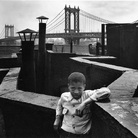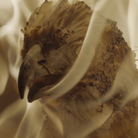Guardando avanti. L’evoluzione dell’arte del fare. 9 storie dal Veneto: digitale – non solo digitale

56. Esposizione Internazionale d'Arte, Venezia, padiglione centrale ai Giardini
Dal 9 May 2015 al 22 November 2015
Venezia
Luogo: Biennale Giardini / Pad. Veneto
Indirizzo: Giardini della Biennale
Curatori: Aldo Cibic
La Biennale di Venezia, presieduta da Paolo Baratta, presenta la mostra del Padiglione Venezia (Giardini) nell’ambito della 56. Esposizione Internazionale d’Arte (9 maggio > 22 novembre 2015), intitolata Guardando avanti. L’evoluzione dell’arte del fare. 9 storie dal Veneto: digitale – non solo digitale e curata da Aldo Cibic.
“La Biennale di Venezia ha voluto quest’anno impegnarsi direttamente nel Padiglione Venezia – ha dichiarato il Presidente Baratta - per un’iniziativa a un tempo antica e rivolta al futuro. Il Padiglione, dedicato nel tempo anche alle Arti Applicate, ne riprende con questa iniziativa il filo, se pur in una direzione diversa e aggiornata: quella delle applicazioni più recenti dell'alta tecnologia”.
La mostra incrocerà pertanto la creatività artistica con le nuove tecnologie, presentando 9 storie esemplari dal Veneto.
“Ci si domanda – afferma Baratta - se il progresso delle tecnologie, in particolare la diffusione del digitale, ci conduca verso orizzonti di standardizzazione e uniformità o se offra invece opportunità nuove di sviluppo, di creative diversificazioni e quindi di ricerca di forme nuove.”
“La Biennale vuole indagare questo fenomeno – chiarisce Baratta - e con la mostra-ricerca digitale – non solo digitale intende rivolgersi appunto a quegli esempi dove le due Muse, quella della tecnologia e quella del sapere esperienziale, insieme danno vita a fenomeni significativi nell'evoluzione delle forme. Per la Biennale si tratta di un primo passo. Si tratta di una ricerca alla quale intende dedicare parte delle sue energie anche in futuro.”
“Incominciamo osservando la realtà che ci circonda, precisa Baratta. Abbiamo scelto, infatti, di indagare sui fenomeni sviluppatisi recentemente nella regione del Veneto. Intendiamo in prospettiva dilatare lo sguardo. Stiamo sviluppando rapporti anche con importanti istituti internazionali.”
“Ancorché trattasi per alcuni aspetti di un ritorno alla storia del Padiglione Venezia – conclude il Presidente - per altri aspetti e per i suoi contenuti tale scelta va vista come una prima pietra di un edificio che andremo a costruire, di un filone di ricerca che andremo a sviluppare, certi di rispondere con questa iniziativa a domande e sollecitazioni che ci vengono dalla società civile e produttiva, alle prese con imprescindibili radicali mutamenti, e che la Biennale, che per sua missione si occupa della "forma" data alle creazioni dell'uomo in tanti settori, e per i quali pure la domanda posta può essere pertinente, non può ignorare.
“Con diversi media, nella mostra sono rappresentati i modi in cui i vari processi si sono sviluppati, spiega il curatore Aldo Cibic. Per citare alcuni esempi, si va dal come si è riusciti a realizzare prodotti d’avanguardia usando tecniche del passato, all’ideazione di attrezzature che salvano la vita delle persone, alla possibilità di coniugare social-network e produzione o ancora di essere unici nel produrre oggetti d’uso.”
Cibic sottolinea che “a completamento del progetto vengono presentate le testimonianze di coloro che, in diverse parti del mondo (e si tratta di grandi designer, ricercatori di livello internazionale, committenti sofisticati che hanno trovato qui il loro miglior produttore), hanno scelto di lavorare con queste persone, riconoscendo la peculiarità della loro “art of making”.”
Sono 9 le storie dal Veneto illustrate nel percorso di mostra, che testimoniano l’evoluzione dell’arte del fare nel Veneto:
1. La fabbrica lenta
2. Sicurezza su misura
3. La sofisticazione del ferro
4. Produttori in rete per giovani creativi
5. Da Los Angeles alle Dolomiti
6. Un design editor e i suoi designer
7. Cucire un sogno
8. Ridisegnare il caldo
9. Maestri della plastica
La mostra è stata realizzata anche grazie al supporto tecnico di Eco Contract + Eco Design, Cleaf SpA, Fondazione Bisazza.
“La Biennale di Venezia ha voluto quest’anno impegnarsi direttamente nel Padiglione Venezia – ha dichiarato il Presidente Baratta - per un’iniziativa a un tempo antica e rivolta al futuro. Il Padiglione, dedicato nel tempo anche alle Arti Applicate, ne riprende con questa iniziativa il filo, se pur in una direzione diversa e aggiornata: quella delle applicazioni più recenti dell'alta tecnologia”.
La mostra incrocerà pertanto la creatività artistica con le nuove tecnologie, presentando 9 storie esemplari dal Veneto.
“Ci si domanda – afferma Baratta - se il progresso delle tecnologie, in particolare la diffusione del digitale, ci conduca verso orizzonti di standardizzazione e uniformità o se offra invece opportunità nuove di sviluppo, di creative diversificazioni e quindi di ricerca di forme nuove.”
“La Biennale vuole indagare questo fenomeno – chiarisce Baratta - e con la mostra-ricerca digitale – non solo digitale intende rivolgersi appunto a quegli esempi dove le due Muse, quella della tecnologia e quella del sapere esperienziale, insieme danno vita a fenomeni significativi nell'evoluzione delle forme. Per la Biennale si tratta di un primo passo. Si tratta di una ricerca alla quale intende dedicare parte delle sue energie anche in futuro.”
“Incominciamo osservando la realtà che ci circonda, precisa Baratta. Abbiamo scelto, infatti, di indagare sui fenomeni sviluppatisi recentemente nella regione del Veneto. Intendiamo in prospettiva dilatare lo sguardo. Stiamo sviluppando rapporti anche con importanti istituti internazionali.”
“Ancorché trattasi per alcuni aspetti di un ritorno alla storia del Padiglione Venezia – conclude il Presidente - per altri aspetti e per i suoi contenuti tale scelta va vista come una prima pietra di un edificio che andremo a costruire, di un filone di ricerca che andremo a sviluppare, certi di rispondere con questa iniziativa a domande e sollecitazioni che ci vengono dalla società civile e produttiva, alle prese con imprescindibili radicali mutamenti, e che la Biennale, che per sua missione si occupa della "forma" data alle creazioni dell'uomo in tanti settori, e per i quali pure la domanda posta può essere pertinente, non può ignorare.
“Con diversi media, nella mostra sono rappresentati i modi in cui i vari processi si sono sviluppati, spiega il curatore Aldo Cibic. Per citare alcuni esempi, si va dal come si è riusciti a realizzare prodotti d’avanguardia usando tecniche del passato, all’ideazione di attrezzature che salvano la vita delle persone, alla possibilità di coniugare social-network e produzione o ancora di essere unici nel produrre oggetti d’uso.”
Cibic sottolinea che “a completamento del progetto vengono presentate le testimonianze di coloro che, in diverse parti del mondo (e si tratta di grandi designer, ricercatori di livello internazionale, committenti sofisticati che hanno trovato qui il loro miglior produttore), hanno scelto di lavorare con queste persone, riconoscendo la peculiarità della loro “art of making”.”
Sono 9 le storie dal Veneto illustrate nel percorso di mostra, che testimoniano l’evoluzione dell’arte del fare nel Veneto:
1. La fabbrica lenta
2. Sicurezza su misura
3. La sofisticazione del ferro
4. Produttori in rete per giovani creativi
5. Da Los Angeles alle Dolomiti
6. Un design editor e i suoi designer
7. Cucire un sogno
8. Ridisegnare il caldo
9. Maestri della plastica
La mostra è stata realizzata anche grazie al supporto tecnico di Eco Contract + Eco Design, Cleaf SpA, Fondazione Bisazza.
SCARICA IL COMUNICATO IN PDF
COMMENTI

-
 Dal 2 December 2025 al 19 February 2026
Milano | Centro Culturale di Milano
Dal 2 December 2025 al 19 February 2026
Milano | Centro Culturale di Milano
Walter Rosenblum. Il mondo e la tenerezza
-
 Dal 30 November 2025 al 12 April 2026
Gallarate | Museo MA*GA
Dal 30 November 2025 al 12 April 2026
Gallarate | Museo MA*GA
Kandinsky e l’Italia
-
 Dal 29 November 2025 al 12 April 2026
Roma | Musei Capitolini
Dal 29 November 2025 al 12 April 2026
Roma | Musei Capitolini
La Grecia a Roma
-
 Dal 22 November 2025 al 3 May 2026
Torino | Sale Chiablese dei Musei Reali
Dal 22 November 2025 al 3 May 2026
Torino | Sale Chiablese dei Musei Reali
Orazio Gentileschi. Un pittore in viaggio
-
 Dal 20 November 2025 al 25 January 2026
Firenze | Palazzo Strozzi
Dal 20 November 2025 al 25 January 2026
Firenze | Palazzo Strozzi
Andro Eradze. Bones of Tomorrow
-
 Dal 21 November 2025 al 28 March 2026
Cuneo | Complesso Monumentale di San Francesco
Dal 21 November 2025 al 28 March 2026
Cuneo | Complesso Monumentale di San Francesco
La Galleria Borghese. Da Raffaello a Bernini. Storia di una collezione


